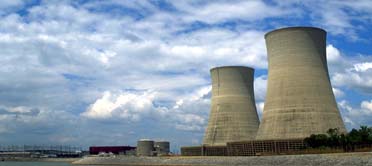Sequoyah Nuclear Plant

Sequoyah Nuclear Plant is located in east Tennessee 18 miles north of Chattanooga, on the banks of Chickamauga Reservoir. Sequoyah is TVA’s second nuclear power plant. Construction began in 1969, and Unit 1 began full commercial operation in 1981. Unit 2 began operation the following year.
Nuclear power production
The operating units at Sequoyah are pressurized water nuclear reactors. The plant makes electricity by splitting uranium atoms to produce steam. The steam is piped to turbines, which spin generators to produce electricity.
Once the steam leaves the turbine it is cooled in an area called a condenser and changes back to water. The water is pumped back to the reactor to begin the process again.
Uranium fuel for the reactors is refined from ore, formed into ceramic pellets, and placed in metal tubes called fuel rods. About 51,000 fuel rods go into the reactor vessel to make up the core—the part of the plant that produces heat.
The splitting uranium atoms raise the temperature of the water surrounding the fuel assemblies to about 580 degrees Fahrenheit. Because this water is under high pressure it doesn’t boil.
The pressurized water goes to tubes inside four steam generators. A secondary supply of water passes around the outside of the tubes in the steam generators. This second source of water boils and turns to steam, which is piped to the turbines to drive the generators and produce electricity.
Control rods and borated water are used to control the splitting of atoms, or fission, of the uranium atoms. The borated water speeds up or slows down the fission process. The control rods shut down the reactor when they are inserted between the fuel rods.
